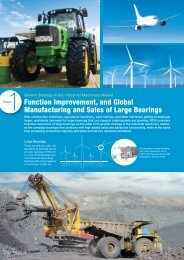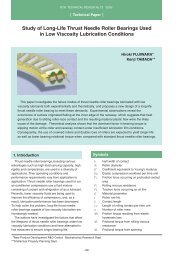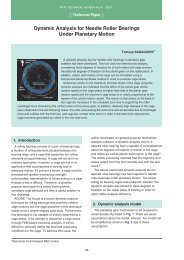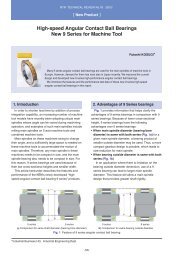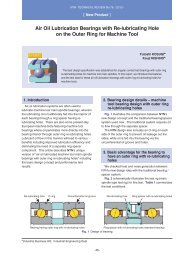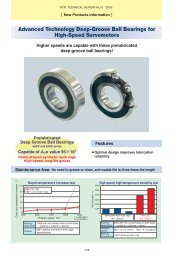Special Issue; Products for Industrial Machinery - NTN
Special Issue; Products for Industrial Machinery - NTN
Special Issue; Products for Industrial Machinery - NTN
You also want an ePaper? Increase the reach of your titles
YUMPU automatically turns print PDFs into web optimized ePapers that Google loves.
"Hybrid Bearphite" a Sintered Metal Sliding Bearing Inserted with Plastic<br />
Furthermore, the oil-impregnated silica particles link<br />
with each other and function as passages <strong>for</strong> the oil.<br />
Through these passages, the oil inside the material is<br />
continuously supplied to the sliding surface, thereby<br />
giving the material a stable low friction coefficient.<br />
The resin sliding material 4 was modified so that its<br />
melted viscosity was suitable <strong>for</strong> injection molding and<br />
was adopted <strong>for</strong> the resin layer on the Hybrid<br />
Bearphite.<br />
3.3 Insert injection molding to sintered metal<br />
backing<br />
The factors that help ensure high accuracy with the<br />
Hybrid Bearphite sliding bearing are summarized in<br />
Fig. 7. As already mentioned, if a resin layer is <strong>for</strong>med<br />
on the bore surface of a conventional metal member,<br />
peeling will unavoidably occur on the metal-resin<br />
interface due to molding-induced shrinking with the<br />
resin material. For our Hybrid Bearphite sliding<br />
bearing design, a resin material is allowed to fill the<br />
pores on the sintered metal so that, due to the<br />
Sintered metal backing<br />
Resin sliding material<br />
Injection-molding conditions<br />
Design<br />
Porosity ratio<br />
Strength and rigidity<br />
Linear expansion coefficient<br />
Melting viscosity<br />
Injection pressure<br />
Die temperature<br />
Die structure (gate)<br />
Resin layer thickness<br />
Fig. 7 Factors to achieve high precision<br />
resultant anchoring effect, the resin layer does not<br />
come off the metal backing. There<strong>for</strong>e, we attempted<br />
to optimize the porosity ratio of the surface of the<br />
sintered metal as well as the injection molding<br />
conditions.<br />
Fig. 8 shows an example of optimization of the<br />
surface porosity ratio with a sintered metal backing.<br />
Fig. 8(a) illustrates a standard sintered metal <strong>for</strong> an<br />
oil-impregnated sliding bearing. Fig. 8(b) provides an<br />
example of optimization of the surface porosity ratio<br />
through adjustment <strong>for</strong> grain size of the starting metal<br />
powder and molding pressures. Both Fig. 8(a) and<br />
Fig. 8(b) show the surfaces of the sintered metal prior<br />
to insert-molding with a resin material (black areas<br />
denote pores) as well as a view of the surfaces of the<br />
sintered metal after the resin layer <strong>for</strong>med by insertmolding<br />
had been stripped off by <strong>for</strong>ce. The surface<br />
shown in Fig. 8(a) where the resin layer was stripped<br />
off does not show traces of the previously deposited<br />
resin, suggesting that the resin did not fill the pores.<br />
In contrast, with the example in Fig. 8(b), the resin<br />
layer itself was split, and this suggests that the<br />
bonding of the resin layer to the sintered metal was<br />
very strong. As can be understood from this fact, the<br />
bonding strength of the sintered metal backing and<br />
resin layer is very high with our Hybrid Bearphite.<br />
4. Per<strong>for</strong>mance of Hybrid Bearphite<br />
Fig. 9 shows the appearance of our Hybrid<br />
Bearphite, which is essentially a sintered metal sliding<br />
bearing with a resin insert. The example in this photo<br />
has a resin layer on its side faces in order to be able<br />
to bear not only a radial load but also an axial load.<br />
The thickness of the resin layers on the bore surface<br />
and end faces is 0.25 mm. The per<strong>for</strong>mance of our<br />
Hybrid Bearphite is described below.<br />
Surface of sintered metal<br />
be<strong>for</strong>e insert molding<br />
Surface with resin layer<br />
stripped off<br />
(a) Standard sintered metal<br />
Resin<br />
Fig. 9 Appearance of HYBRID BEARPHITE<br />
(b) Optimized sintered metal<br />
<br />
Fig. 8 Inner surface of sintered back metal<br />
-111-




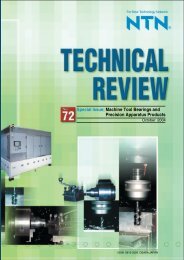
![[New Product] Unit Products for Office Equipment - NTN](https://img.yumpu.com/27154451/1/184x260/new-product-unit-products-for-office-equipment-ntn.jpg?quality=85)
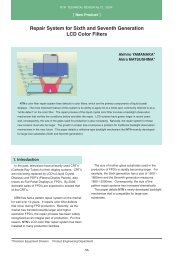
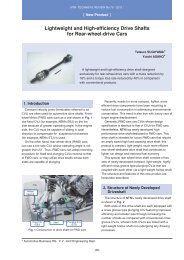
![[New Product] Development of Oil-impregnated Sintered ... - NTN](https://img.yumpu.com/27154427/1/184x260/new-product-development-of-oil-impregnated-sintered-ntn.jpg?quality=85)

